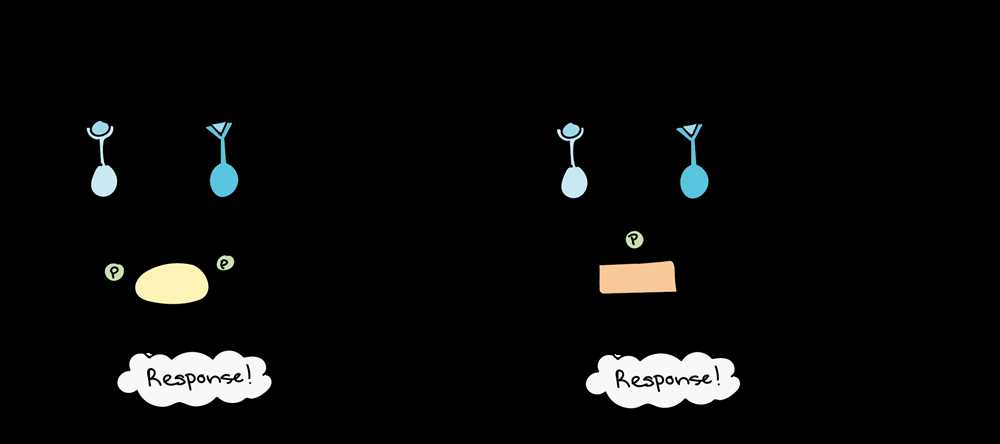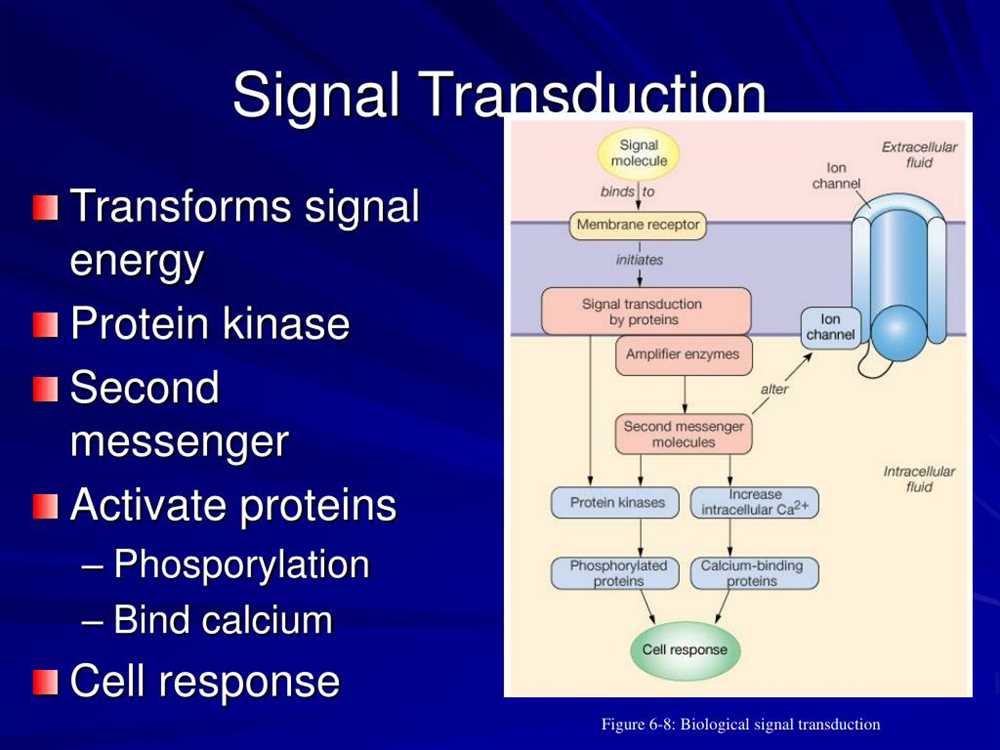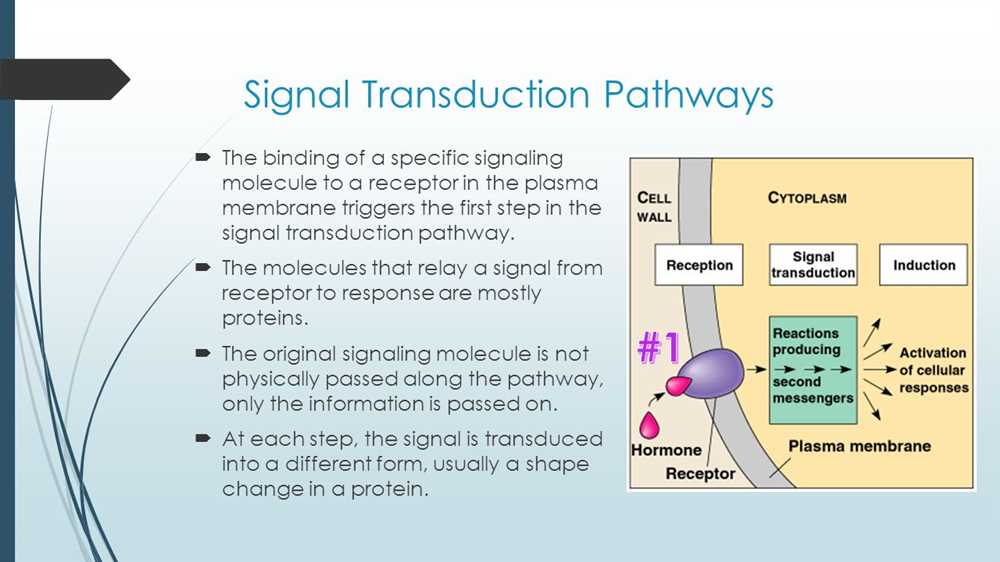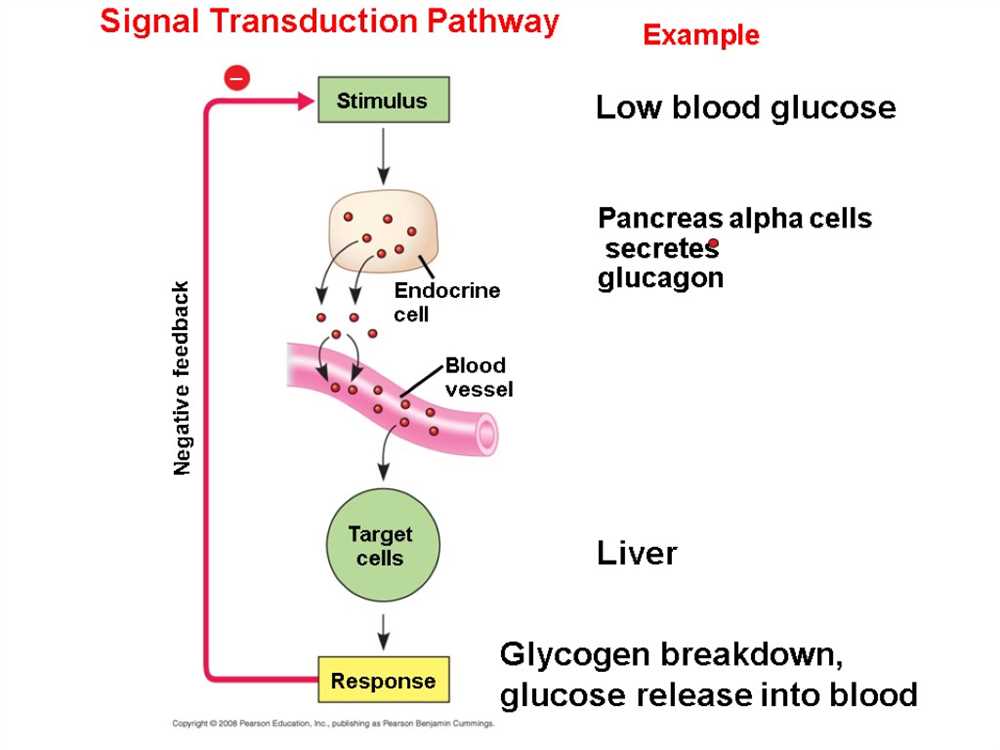
In the field of biology, signal transduction plays a crucial role in the communication between cells. It involves the transmission of signals from the outside environment to the inside of the cell, leading to various cellular responses. Understanding the mechanisms of signal transduction is vital for comprehending how cells communicate and regulate their activities.
One way cells communicate is through signaling pathways, which involve a series of molecular events that transmit information within the cell. These pathways can be activated by various external signals, such as hormones, growth factors, or neurotransmitters. The signal transduction process often involves the binding of a ligand to a receptor on the cell surface, triggering a cascade of intracellular events.
In a signal transduction pathway, different molecules act as messengers to transmit the signal from the receptor to the target molecules within the cell. These messengers can be proteins, ions, or small molecules. They relay the signal by undergoing structural changes or activating enzymes, leading to the activation or inhibition of specific cellular processes.
Understanding the intricacies of signal transduction and communication is essential for advancing our knowledge of cellular processes and developing targeted therapies for various diseases. This webquest provides answers to questions related to signal transduction, offering insights into the mechanisms and importance of this fundamental biological process. By exploring these answers, readers can gain a deeper understanding of how cells communicate and the impact it has on their overall function.
Section 1: What is signal transduction and communication?
Signal transduction refers to the process by which cells receive and interpret signals from their environment. It is a crucial mechanism for cells to communicate with each other and coordinate their activities. Communication, on the other hand, is the exchange of information between cells or organisms, which can be done through various means, including chemical signals such as hormones, neurotransmitters, and growth factors.
In signal transduction, the signal is first received by a receptor on the cell surface or inside the cell. This receptor then initiates a series of intracellular signaling events, which often involve the activation of various signaling molecules and pathways. These pathways can include phosphorylation cascades, second messenger systems, or gene regulation mechanisms. Ultimately, the signal is transmitted to the cell’s nucleus, where it can lead to changes in gene expression or other cellular responses.
Signal transduction and communication are essential for the proper functioning of cells and organisms. They play crucial roles in many physiological processes, including development, immune response, and cell growth and differentiation. Disruptions in signal transduction pathways can lead to various diseases, such as cancer, diabetes, and neurological disorders.
In summary, signal transduction and communication are fundamental processes that enable cells to respond to signals from their environment and coordinate their activities. These processes involve the reception and interpretation of signals, as well as the transmission of these signals to the cell’s nucleus. Understanding the mechanisms of signal transduction and communication is crucial for advancing our knowledge of cellular biology and developing new therapeutic strategies for diseases.
Understanding the basics of signal transduction
In cellular biology, signal transduction refers to the process by which cells communicate and respond to external signals. It plays a crucial role in various biological processes, including cell growth, differentiation, and survival. Understanding the basics of signal transduction is essential to comprehend the intricate mechanisms that regulate cellular functions.
At its core, signal transduction involves a sequence of molecular events that transmit information from the extracellular environment into the cell’s interior. This process allows cells to detect and respond to changes in their surroundings, ensuring their survival and efficient functioning. One key element of signal transduction is the molecule known as a receptor, which is usually located on the cell membrane. Receptors can recognize specific molecules, such as hormones or neurotransmitters, and initiate a cascade of events within the cell once these molecules bind to them.
The transportation of signals inside the cell typically involves a series of biochemical reactions and signaling molecules. These signaling molecules, called second messengers, act as intermediaries, transmitting the signal from the receptor to the cell’s interior. Common second messengers include cyclic AMP (cAMP), calcium ions (Ca2+), and inositol trisphosphate (IP3). Once the signal reaches the cell’s interior, it can trigger various cellular responses, such as changes in gene expression, activation of enzymes, or alterations in cellular metabolism.
Signal transduction pathways can be highly complex, involving multiple steps and interactions between different molecules. They often form intricate networks with feedback loops and cross-talk, allowing for precise regulation of cellular processes. Dysfunctions in signal transduction pathways can lead to various diseases, including cancer, cardiovascular disorders, and immune system disorders. Therefore, studying signal transduction is crucial for the development of targeted therapies and treatments for these diseases.
Section 2: Importance of signal transduction and communication
Signal transduction and communication are essential processes for the survival and proper functioning of living organisms. They allow cells to respond to various types of signals from their environment, such as chemical, hormonal, or physical cues, and transmit these signals to the appropriate target cells or tissues.
Signal transduction is the process by which cells convert the information carried by extracellular signals into intracellular responses. These signals can originate from other cells, tissues, or the surrounding environment. Through signal transduction, cells can coordinate their activities, regulate their growth and development, and respond to changes in their environment.
Communication between cells is crucial for the proper functioning of multicellular organisms. It enables cells to coordinate their activities and work together to maintain homeostasis and carry out complex physiological processes. Communication can occur through direct cell-to-cell contact, release of signaling molecules into the extracellular space, or via electrical or mechanical signals.
Understanding signal transduction and communication is vital for various fields, including biology, medicine, and biotechnology. It helps us comprehend how cells communicate, how they interpret and respond to signals, and how dysfunction in these processes can lead to diseases and disorders. Additionally, studying signal transduction and communication can provide insights into the development of new therapeutic strategies that target specific signaling pathways or molecules to treat various diseases.
In summary, signal transduction and communication play fundamental roles in the functioning of living organisms. They enable cells to respond and adapt to their environment, coordinate their activities, and carry out complex physiological processes. Studying these processes is crucial for advancing our understanding of biology and developing new therapeutic approaches.
The Role of Signal Transduction in Cell Communication

Signal transduction is a crucial process in cell communication, allowing cells to detect and respond to signals from their environment. It involves the conversion of extracellular signals into intracellular signals, which then trigger specific cellular responses. This process plays a fundamental role in maintaining homeostasis and coordinating cellular activities in multicellular organisms.
When a signal is received by a cell, it binds to a specific receptor on the cell membrane or inside the cell. This binding event initiates a series of molecular events known as signal transduction pathways. These pathways involve the activation of various signaling molecules, such as proteins and enzymes, which transmit the signal to different cellular targets. The signaling molecules can either amplify or dampen the signal, depending on the specific cellular response required.
One example of signal transduction in cell communication is the activation of the insulin signaling pathway in response to high blood sugar levels. When blood sugar levels rise, insulin is released by pancreatic beta cells and binds to insulin receptors on muscle and fat cells. This activation triggers a cascade of events, including the phosphorylation of insulin receptor substrates (IRS), which then activate PI3K (phosphatidylinositol 3-kinase). PI3K produces a secondary messenger called PIP3, which activates signaling proteins such as AKT. AKT then promotes the uptake of glucose from the bloodstream into cells, lowering blood sugar levels.
Overall, signal transduction is a complex but essential process in cellular communication. It allows cells to respond and adapt to changing environmental conditions, ensuring the proper functioning and survival of organisms. By understanding the mechanisms of signal transduction, scientists can gain insights into various diseases and develop targeted therapies to manipulate these pathways for therapeutic purposes.
Section 3: Components of signal transduction pathways

Signal transduction pathways are complex networks of molecular interactions that allow cells to communicate and respond to external signals. These pathways involve various components that work together to transmit and amplify signals, ultimately leading to specific cellular responses. Understanding the key components of signal transduction pathways is essential for studying cellular communication and developing targeted therapeutic interventions.
Receptors: Receptors are proteins located on the surface or inside the cell that recognize and bind to specific signaling molecules or ligands. They play a crucial role in initiating signal transduction by initiating a cascade of events upon ligand binding. There are different types of receptors, including cell-surface receptors, nuclear receptors, and enzyme-linked receptors.
Second messengers: Second messengers are small molecules or ions that act as intermediaries in signal transduction pathways. They are produced in response to the activation of receptors and help propagate the signal from the cell surface to the intracellular target molecules. Common examples of second messengers include cyclic AMP (cAMP), inositol trisphosphate (IP3), and calcium ions (Ca2+).
Protein kinases: Protein kinases are enzymes that catalyze the transfer of phosphate groups from ATP to specific target proteins, a process known as phosphorylation. Phosphorylation plays a crucial role in signal transduction as it can activate or deactivate target proteins, thereby modulating their activity. Protein kinases are essential components of many signaling pathways and are often regulated themselves by other components.
Transcription factors: Transcription factors are proteins that bind to specific DNA sequences and regulate gene expression. They play a critical role in signal transduction by modulating the transcription of target genes in response to signaling events. Transcription factors can be activated or inhibited by various signaling pathways, allowing for precise control of gene expression and cellular responses.
Effector proteins: Effector proteins are downstream targets of signaling pathways that directly carry out the cellular responses. They can be enzymes, structural proteins, or other molecules that initiate specific cellular processes such as cell division, apoptosis, or changes in cytoskeletal dynamics. Effector proteins act as the final step in signal transduction, translating the incoming signals into observable cellular changes.
In summary, signal transduction pathways involve a complex interplay of receptors, second messengers, protein kinases, transcription factors, and effector proteins. Understanding the components and their interactions is crucial for deciphering the mechanisms of cellular communication and designing targeted interventions to modulate these pathways.
Analyzing the key components involved in signal transduction

In the process of signal transduction, cells receive and respond to external signals in order to carry out appropriate physiological responses. This complex process involves several key components that work together to ensure the accurate transmission of signals and the activation of specific cellular pathways.
One of the key components of signal transduction is the cell surface receptor. These receptors are often proteins located on the cell membrane that are specific to particular signals, such as hormones or neurotransmitters. When a signal molecule binds to its corresponding receptor, it triggers a conformational change in the receptor that initiates the transduction of the signal to the inside of the cell.
Intracellular signaling molecules play a crucial role in signal transduction by relaying the signal from the receptor to the effector molecules in the cell. These molecules can be enzymes, ions, or other proteins that act as intermediaries in the signaling pathway. They often work in a cascade, where one molecule activates the next in line, amplifying the signal and ensuring a precise response.
To further amplify and regulate the signal, cells employ a variety of secondary messengers. These small molecules, such as cyclic AMP (cAMP) or calcium ions, are produced or released in response to the initial signal and act as signal transmitters within the cell. They can activate or inhibit specific enzymes or ion channels, leading to the initiation or termination of cellular responses.
The
- final effector components
of signal transduction pathways are responsible for carrying out the specific cellular response to the signal. These effector molecules can include enzymes, ion channels, or transcription factors. Depending on the nature of the signal and the specific pathway involved, the cellular response can range from changes in gene expression to alterations in metabolism or cell behavior.
In conclusion, signal transduction is a highly coordinated process involving various key components, including cell surface receptors, intracellular signaling molecules, secondary messengers, and effector molecules. These components work together to ensure the accurate transmission of signals and the appropriate activation of specific cellular responses. Understanding the mechanisms and interactions of these components is crucial for unraveling the complexities of signal transduction and its role in cellular communication and function.